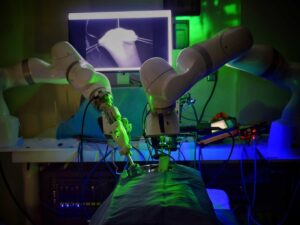In a discovery that blurs the lines between artificial and organic intelligence, scientists in 2025 have successfully merged lab-grown human brain cells with AI chips to create the world’s first fully functional biohybrid computing platform. The breakthrough, achieved through a collaboration between the University of Oxford and Monash University, could redefine how machines think, learn, and adapt.
The research — published in Nature Neuroscience this April — introduces a new computing field dubbed “organoid intelligence”, where neural tissue grown in labs is used to perform AI tasks with greater efficiency and lower energy consumption than traditional silicon chips.
What Are Brain Cell Chips?
At the core of this breakthrough are organoids — tiny clumps of lab-grown human brain cells that mimic some functions of the human cortex. These organoids were placed on specially engineered electrodes, allowing two-way communication between biological neurons and digital systems.
In tests, these biochips demonstrated the ability to:
- Learn patterns faster than conventional AI systems
- Use 1,000x less energy than modern GPUs
- Show early signs of adaptive memory formation
Source: Nature Neuroscience, April 2025
How Biohybrid Computing Works
The chips use electronic interfaces and nanoscale sensors to connect AI algorithms with living neurons. As the organoids grow and respond to stimuli, they can be trained to recognize data patterns — such as changes in sound, images, or movement — similarly to how a human brain learns.
The system can also \”forget\” irrelevant inputs over time, which is a feature current AI models struggle to replicate.
Why This Matters
This biohybrid architecture could revolutionize:
- Energy-efficient AI: Ideal for edge computing and wearable devices
- Neuroscience research: Enabling better models of diseases like Alzheimer’s
- Brain-machine interfaces: Creating more natural interactions with prosthetics and robotics
Because the biological components are self-organizing and plastic, they may eventually lead to **AI systems that can evolve organically**, not just through code.
Europe’s Role in Organoid AI
This project is part of the EU-Australia Horizon Science Exchange Program, funded under the Horizon Europe framework. The University of Oxford’s Institute of Neurotechnology is leading the ethical research wing, ensuring the project complies with the EU Charter of Fundamental Rights regarding synthetic biology.
Additionally, researchers from Germany’s Max Planck Institute and France’s CNRS are helping develop safety protocols for scaling brain-based AI in consumer devices.
Ethical and Philosophical Questions
As with any human-biological integration, the rise of organoid intelligence raises deep ethical questions:
- At what point does a brain chip become sentient?
- Should lab-grown neural tissue have rights?
- Can AI with organic memory experience emotion or awareness?
Bioethicists are now working with the European Commission to draft the world’s first **Organoid AI Ethics Guidelines**, expected later this year.
Conclusion
The fusion of human brain cells with artificial intelligence is no longer science fiction — it’s happening now. As we enter the age of organoid computing, the machines of the future may not just run on silicon and software, but on living cells that learn, adapt, and possibly even think.
In 2025, the question is no longer whether AI can replicate human intelligence — but whether it can grow into it, organically.




